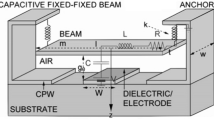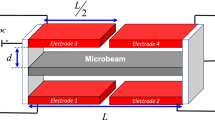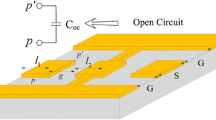Abstract
This paper reports a model and investigates into capacitive studies of microelectromechanical system switch through considerations of material’s behavior on various parameters like dielectric thickness, thickness and width of bridge structure and also with distance between two electrodes including fringe field effect on pull up and down capacitance. The pull up capacitance and pull-down capacitances are investigated considering effect of fringe field and holes independently as well as combined together. In pull up state, the total capacitance is found to be 6.9945 fF in which three components of the capacitance \( C_{1,u} \), \( C_{2,u} \) and \( C_{3,u} \) contribute 1.1624 fF (16.61%), 2.1924 fF (31.34%) and 3.6397 fF (52.03%) respectively. In pull down state, the total capacitance is found as 2.1439 pF and capacitance sharing of each component (\( C_{1,d} \)), (\( C_{2,d} \)) and (\( C_{3,d} \)) is 0.6503 pF (30.33%), 1.1164 pF (52.07%) and 0.3772 pF (17.59%) respectively. The pull-down capacitance (\( C_{t,d} \)) and pull up capacitance (\( C_{t,u} \)) ratio is also calculated and \( \left( {\frac{{C_{t,d} }}{{C_{t,u} }}} \right)_{max} \) using model is found as 521.64. The capacitance ratio range is also calculated and range is 48.41–521.64. This model can be used to measure the capacitances in symmetric and asymmetric microelectromechanical switch with error range 2–5%.

















Similar content being viewed by others
Change history
07 January 2020
The original version of this article unfortunately contains a typing error. Last term of Eq. (5) and brackets were incorrectly placed while article preparation and the correct version of that equation should be
07 January 2020
The original version of this article unfortunately contains a typing error. Last term of Eq.��(5) and brackets were incorrectly placed while article preparation and the correct version of that equation should be
References
Agarwal S, Kashyap R, Guha K, Baishya S (2017) Modeling and analysis of capacitance in consideration of the deformation in RF MEMS shunt switch. Superlattices Microstruct 101:567–574. https://doi.org/10.1016/j.spmi.2016.10.022
Al-Dahleh R, Mansour RR (2010) High-capacitance-ratio warped-beam capacitive MEMS switch designs. J Microelectromech Syst 19(3):538–547. https://doi.org/10.1109/JMEMS.2010.2048012
Attaran A, Rashidzadeh R (2015) Ultra low actuation voltage RF MEMS switch. Micro Nano Syst Lett 3(7):1–4
Banerjee A, Pandey SS, Mastrangelo CH (2017) MEMS stiction supression with sacrificial polystyrene nanoparticles. IEEE Sens 2017:1–3. https://doi.org/10.1109/ICSENS.2017.8233922
Giounanlis P, Andrade-Miceli D, Gorreta S, Pons-Nin J, Dominguez-Pumar M, Blokhina E (2016a) Circuit modeling of a MEMS varactor including dielectric charging dynamics. J Phys Conf Ser 757(1):1–6
Giounanlis et al (2016b) Sigma-delta effects and charge locking in capacitive MEMS under dielectric charge control. TCAS II 64:206–210
Gong Z, Liu H, Guo X et al (2018) Optimization of a MEMS variable capacitor with high linearity and large tuning ratio. Microsyst Technol 24(7):3169–3178. https://doi.org/10.1007/s00542-018-3844-z
Guha K, Kumar M, Agarwal S, Baishya S (2015) A modified capacitance model of RF MEMS shunt switch incorporating fringing field effects of perforated beam. Solid State Electron 114:35–42. https://doi.org/10.1016/j.sse.2015.07.008
Han K, Guo X, Smith S, Deng S, Li W (2018a) Novel high-capacitance-ratio MEMS switch: design, analysis and performance verification. Micromachines 9(8):390. https://doi.org/10.3390/mi9080390
Han K, Guo X, Smith S, Deng Z, Li W (2018b) Novel high-capacitance-ratio MEMS switch: design, analysis and performance verification. Micromachines 9(8):1–11. https://doi.org/10.3390/mi9080390
Iannacci J, Del Tin L, Gaddi R, Gnudi A and Rangra KJ (2005) Compact modeling of a MEMS toggle-switch based on modified nodal analysis. In: Proceedings of symposium on design, test, integration and packaging of MEMS/MOEMS (DTIP 2005), Montreux, Switzerland; 01–03 June 2005. pp 411–416, ISBN: 2-84813-0357-1
Jain A et al (2011) A physics-based predictive modeling framework for dielectric charging and creep in RF MEMS capacitive switches and varactors. J Microelectromech Syst 21:420–430
Keimel C, Claydon G, Li B, Park JN, Valdes ME (2012) Microelectromechanical-systems-based switches for power applications. IEEE Trans Ind Appl 48(4):1163–1169. https://doi.org/10.1109/tia.2012.2199949
Koutsoureli M, Birmpiliotis D, Michalas L, Papaioannou G (2016) An in-depth analysis of pull-up capacitance-voltage characteristic for dielectric charging assessment of MEMS capacitive switches. Microelectron Reliab 64:688–692. https://doi.org/10.1016/j.microrel.2016.07.027
Kumar M, Mukherjee B, Swamy KBMM, Sen S (2018) A novel design for enhancing the sensitivity of a capacitive MEMS device. J Microelectromech Syst 27(4):656–666. https://doi.org/10.1109/JMEMS.2018.284242
Kurmendra, Kumar R (2019a) Design and simulation of mems shunt capacitive switch for lower switching time. 3C Technol 8(2):167–178. https://doi.org/10.17993/3ctecno.2019.specialissue.15
Kurmendra, Kumar R (2019b) Design and analysis of MEMS shunt capacitive switch with Si3N4 dielectric and au beam material to improve actuation voltage and RF performance in consideration with and without circular perforations. Trans Electr Electron Mater. https://doi.org/10.1007/s42341-019-00112-y
Kurmendra, Kumar R, Pertin O (2019) Design of an improved micro-electro-mechanical-systems switch for RF communication system. In: Khare A, Tiwary U, Sethi I, Singh N (eds) Recent trends in communication, computing, and electronics. Lecture notes in electrical engineering, vol 524. Springer, Singapore
Lee SD, Jun BC, Kim S, Rhee JK (2005) A novel pull-up type RF MEMS switch with low actuation voltage. IEEE Microw Wirel Compon Lett 15(12):856–858. https://doi.org/10.1109/lmwc.2005.860006
Mafinejad Y, Kouzani A, Mafinezhad K et al (2017) Low insertion loss and high isolation capacitive RF MEMS switch with low pull-in voltage. Int J Adv Manuf Technol 3(1–4):661–670. https://doi.org/10.1007/s00170-017-0558-9
Papaioannou et al (2005) Temperature study of the dielectric polarization effects of capacitive RF MEMS switches. IEEE Trans Microw Theory Tech 53:3467–3473
Pertin O, Kurmendra (2018) Pull-in-voltage and RF analysis of MEMS based high performance capacitive shunt switch. Microelectron J 77:5–15. https://doi.org/10.1016/j.mejo.2018.05.001
Rebeiz GM (2003) RF MEMS theory design and technology. Wiley, New Jersey
Rottenberg X et al (2017) Analytical model of the DC actuation of electrostatic MEMS devices with distributed dielectric charging and nonplanar electrodes. J Microelectromech Syst 16:1243–1253
Saha R, Maity S, Devi NM, Bhunia C (2015) Analysis of pull-in-voltage and figure-of-merit of capacitive MEMS switch. Trans Electr Electron Mater 17(3):129–133
van der Meijs NP, Fokkema JT (1984) VLSI circuit reconstruction from mask topology. Integration 2(2):85–119. https://doi.org/10.1016/0167-9260(84)90016-6
Wei H, Deng Z, Guo X, Wang Y, Yang H (2017) High on/off capacitance ratio RF MEMS capacitive switches. J Micromech Microeng 27(5):1–12
Yang H (2000) Microgyroscope and microdynamics. PhD Dissertation
Acknowledgements
Authors in this work would like to thank staff members and students of Department of Electronics and Communication Engineering, Rajiv Gandhi University, Itanagar, India for showing their support in completion of this work. Authors would also like to express thanks to Department of Electronics and Communication Engineering, NERIST, Itanagar for their kind support.
Author information
Authors and Affiliations
Corresponding author
Additional information
Publisher's Note
Springer Nature remains neutral with regard to jurisdictional claims in published maps and institutional affiliations.
Rights and permissions
About this article
Cite this article
Kurmendra, Kumar, R. Novel capacitance evaluation model for microelectromechanical switch considering fringe and effect of holes in pull-up and pull-down conditions. Microsyst Technol 26, 873–884 (2020). https://doi.org/10.1007/s00542-019-04611-z
Received:
Accepted:
Published:
Issue Date:
DOI: https://doi.org/10.1007/s00542-019-04611-z




